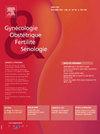[影响宫内节育器置入疼痛的因素]。
IF 0.6
4区 医学
Q4 OBSTETRICS & GYNECOLOGY
引用次数: 0
摘要
目的:在宫内节育器(IUD)插入时对疼痛的恐惧仍然是其采用的障碍。在缺乏最佳药理学策略共识的情况下,确定影响这种疼痛的因素以保证和改善患者体验是至关重要的。方法:这是一项前瞻性研究,于2023年8月至2024年8月在Provence-Alpes-Côte d'Azur进行,采访了成年患者和咨询宫内节育器插入的医疗保健专业人员。研究的主要结果是宫内节育器插入过程中所经历的疼痛,使用从0到10的数值评分量表进行测量。在单变量分析后,进行多元线性回归以确定与这种疼痛相关的因素。结果:在分析的110份问卷中,宫内节育器插入时的平均疼痛评分为4.1+/- 2.7。与疼痛相关的因素包括欧洲血统、无阴道分娩史、恐惧和使用腱带。相比之下,先前的宫内节育器插入,痛经的存在,插入时的月经,或用药前对疼痛没有显著影响。事先膀胱排空和使用等摩尔氧和一氧化二氮混合物(EMONO)也可以作为策略,但需要进一步研究。结论:考虑到宫内节育器插入引起的中度和暂时的疼痛,应尽量减少。医生在识别有增加疼痛风险的患者方面起着关键作用,以便为他们提供个性化的治疗方法。本文章由计算机程序翻译,如有差异,请以英文原文为准。
Facteurs influençant la douleur lors de la pose d’un dispositif intra-utérin
Objectives
Fear of pain during intrauterine device (IUD) insertion remains a barrier to its adoption. In the absence of consensus on an optimal pharmacological strategy, it is crucial to determine the factors influencing this pain to reassure and improve the patient experience.
Methods
It was a prospective study conducted in Provence-Alpes-Côte d’Azur between August 2023 and 2024, interviewing adult patients and healthcare professionals during consultations for IUD insertion. The primary outcome studied was the pain experienced during IUD insertion, measured using a numerical rating scale from 0 to 10. After an univariate analysis, a multiple linear regression was performed to identify the factors associated with this pain.
Results
Of the 110 questionnaires analyzed, the average pain score at IUD insertion was 4.1 ± 2.7. Factors associated with pain included European origin, no history of vaginal delivery, apprehension and use of a tenaculum. In contrast, prior IUD insertion, the presence of dysmenorrhea, menstruation at the time of insertion, or premedication had no significant effect on pain. Prior bladder emptying and the use of equimolar mixture of oxygene and nitrous oxide (EMONO) could also be considered as strategies but require further studies.
Conclusion
IUD insertion should be played down, given the moderate and temporary pain it causes. Physicians have a key role in identifying patients at risk of increased pain in order to provide them a personalized approach.
求助全文
通过发布文献求助,成功后即可免费获取论文全文。
去求助
来源期刊

Gynecologie Obstetrique Fertilite & Senologie
Medicine-Obstetrics and Gynecology
CiteScore
1.70
自引率
0.00%
发文量
170
期刊介绍:
Gynécologie Obstétrique Fertilité & Sénologie est un mensuel scientifique d''information et de formation destiné aux gynécologues, aux obstétriciens, aux sénologues et aux biologistes de la reproduction. La revue, dans ses éditoriaux, articles originaux, mises au point, lettres à la rédaction et autres rubriques, donne une information actualisée ayant trait à l''obstétrique et à la gynécologie et aux différentes spécialités développées à partir de ces deux pôles : médecine de la reproduction, médecine maternelle et fœtale, périnatalité, endocrinologie, chirurgie gynécologique, cancérologie pelvienne, sénologie, sexualité, psychosomatique…
 求助内容:
求助内容: 应助结果提醒方式:
应助结果提醒方式:


